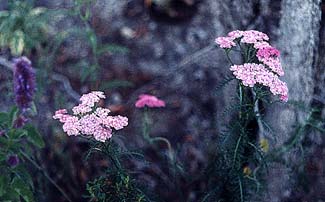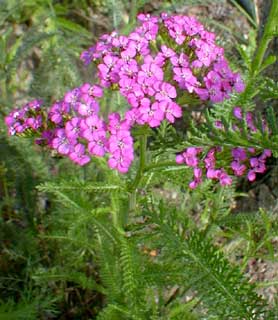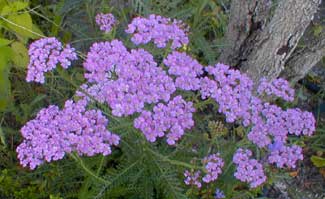
'Lavender Beauty' Yarrow
"Or let their wishes loose, in forest-glade,
Among the lurking powers
Of herbs & lowly flowers,
Or seek, from saints above, miraculous aid."
-William Wordsworth
(1770-1850)
(1770-1850)
'Lavender Beauty' milfoil or yarrow requires full sun in coastal gardens, but can do with a tiny bit of shade in hotter inland gardens. It grows one to two feet in height, & the clump can spread one to two feet wide or wider. Older larger clumps may need to be divided if they appear to drop off in blooming strength, or for reasons of propogation.
'Lavender Beauty' has been marketed alternatively under the names 'Lilac Beauty,' 'Lavender Lady,' & 'Forncett Beauty.' Though some sources suggest two or more under these four names are separate cultivars, they are almost certainly the same.
 The flowers are pale lavender-blue to lavender-pink, sometimes beginning to flower in late spring & inevitably through the whole of summer. Deadheading can extend flowering period into early autumn. If permitted to go to seed it may or may not stop blooming for the rest of the year. It is apt to re-seed but new plants are not likely to be precisely the same color.
The flowers are pale lavender-blue to lavender-pink, sometimes beginning to flower in late spring & inevitably through the whole of summer. Deadheading can extend flowering period into early autumn. If permitted to go to seed it may or may not stop blooming for the rest of the year. It is apt to re-seed but new plants are not likely to be precisely the same color.Native of Eurasia, but now naturalized all around the globe, wild yarrow tends to be white to pink to lavender, hence 'Lavender Beauty' is fairly close in appearance to the original wildflower, though the color has been enhanced.
Although they do extremely well in low-maintenence gardens because drought tolerant, they do in fact bloom more fabulously with periodic watering in spring & summer. If too wet in winter, however, they are apt to rot, so soil should drain extremely well. Overhead watering can sometimes spoil the flowers or shorten their prime appearance, so that ground-level irrigation is recommended.
Our 'Lavender Beauty' & a few others grow near a laurel-like Strawberry Tree so are somewhat protected from overhead rainfall, & the big shrub's root system soaks up excess wetness.
Yarrows need little or no fertilizing to do well, though a slow release plant food early in the year doesn't hurt. They should certainly not be fertilized later in the year, as it is too easy to induce bursts of winter growth which will weaken the plant's performance the following year, or even kill the plant during a good cold-snap, as it needs to be dormant in the winter.
 Though not prone to diseases (except for the possibility of rotting from excess winter moisture), yarrows are suceptible to powdery mildew. If not crowded this oughtn't be a problem, but if the leaves do become mildewy, this will likely be toward the end of the year in the rain season.
Though not prone to diseases (except for the possibility of rotting from excess winter moisture), yarrows are suceptible to powdery mildew. If not crowded this oughtn't be a problem, but if the leaves do become mildewy, this will likely be toward the end of the year in the rain season.There's no sense in "treating" powdery mildew on an achillea. A mildewed clump should just be cut entirely to the ground, the cuttings discarded rather than composted; the trimming will induce some fresh autumn growth, & it will almost certainly be mildew-free the following spring. It is perhaps a good idea not to plant them near beebalms or any other plant notorious for getting powdery mildew, as too many susceptible species in one location is asking for trouble.
They are somewhat less susceptible to rust, which can manifest as raised reddish spots or pustules on the undersides of leaves. Once again, the treatment is completely organic, just cut the plants to the ground, discard rather than compost infected leaves, & let the plant regrow clean of infection.
In many places yarrow is regarded as invasive, though it is only rarely a dominant plant, & cultivars though extremely vigorous are not as aggressive as the wildflower itself.
For over a hundred years in North America, yarrow was traditionally planted by farm wives around stumps or near the edge of cleared land, for it had many uses though it required no care. My own great-grandmother Elvy had them on her land around stumps, & generations of kids came & went every one of them learning techniques of flower-drying thanks to Gram's yarrows.
This tradition insured Eurasian yarrows would naturalize everywhere on the continent. The only farm wives who avoided it were on dairies. If cows did per chance eat the leaves & flowers, it lent a bitter taste to their milk.
It is unpallatable to wildlife though pronghorn antelope, bighorn sheep & a few other animals will graze the flowerheads, as will domestic sheep & especially goats. Cattle & horses will rarely graze the flowers, & almost never graze the bitter leaves.
Continue to:
'White Beauty' Yarrow